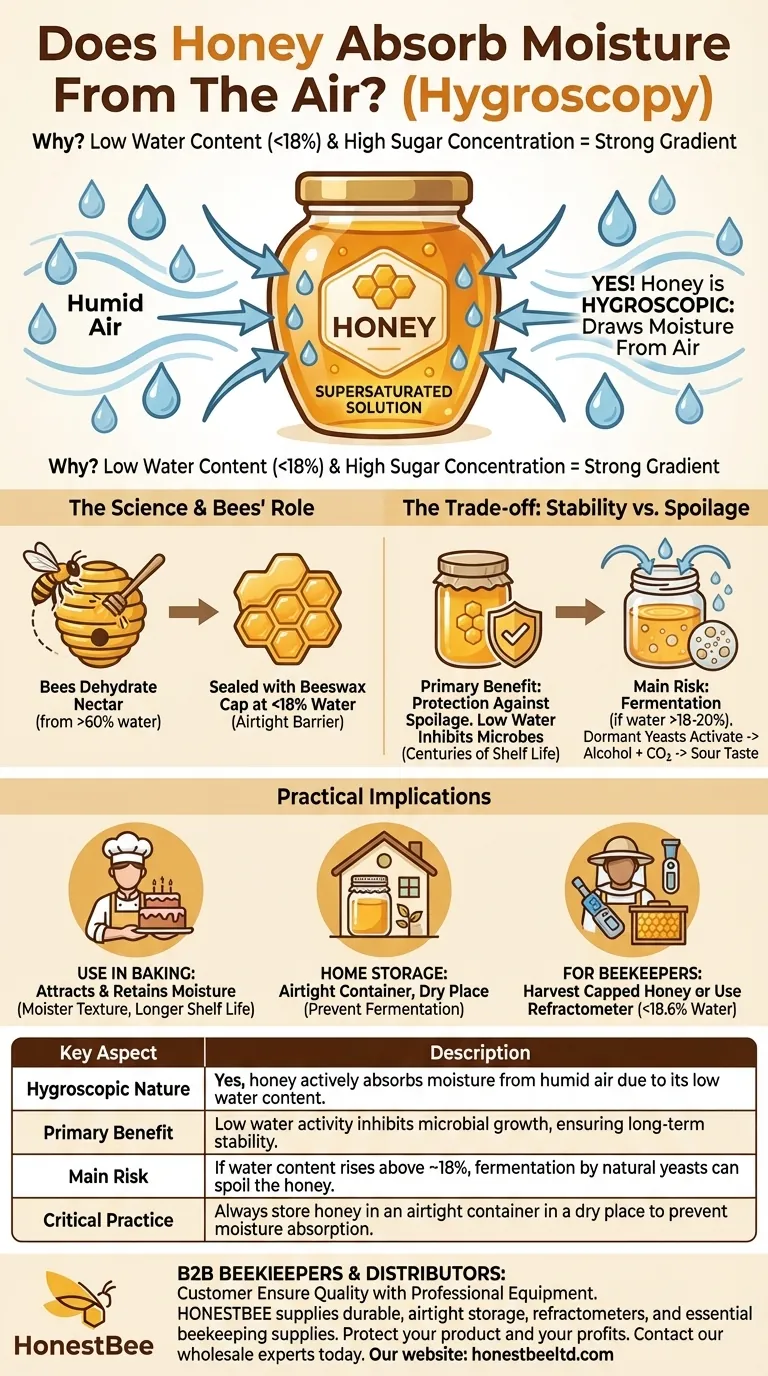Yes, honey is highly effective at absorbing moisture directly from the air. This property is known as hygroscopy, and it is a defining characteristic of honey. The low water content and high sugar concentration create a natural imbalance that actively draws water molecules from the surrounding environment until equilibrium is reached.
Honey's ability to absorb atmospheric moisture is a double-edged sword. This hygroscopic nature is fundamental to its incredible stability and resistance to spoilage, but it also means that improper storage can lead to fermentation and ruin.

What Makes Honey Absorb Moisture?
The tendency for honey to pull in water is not a coincidence; it is a direct result of its unique chemical composition, engineered by bees for long-term preservation.
The Science of Hygroscopy
Honey is a supersaturated solution of sugars, primarily fructose and glucose. It naturally contains very little water—typically less than 18%.
Because of its low water content, honey has low "water activity." This creates a strong gradient, causing it to attract and bond with water molecules from the more humid ambient air.
The Role of Bees in Dehydration
When bees collect nectar, it has a high water content, often over 60%. The bees actively dehydrate the nectar by fanning it with their wings inside the hive.
Once the water content drops below the critical threshold of about 18%, they seal the honeycomb cell with a beeswax cap. This cap creates an airtight barrier, preventing the now-stable honey from reabsorbing moisture and fermenting.
The Practical Implications of This Property
Understanding that honey is hygroscopic is critical for everyone from beekeepers to home cooks. It dictates how honey must be handled and stored to preserve its quality.
Protection Against Spoilage
The low water content of properly cured honey makes it an inhospitable environment for microbes. Bacteria and yeast cannot thrive without sufficient water, which is why sealed honey can last for centuries.
The Risk of Fermentation
If honey is exposed to humid air, it will absorb moisture. As its water content rises above the 18-20% range, dormant, naturally-occurring osmophilic yeasts can become active.
These yeasts begin to metabolize the sugars, producing alcohol and carbon dioxide. This process is fermentation, which spoils the honey, giving it a sour, "off" taste.
Use in Cooking and Baking
This hygroscopic quality is highly valued in baking. Adding honey to recipes for cakes and bread helps the finished product attract and retain moisture, resulting in a moister texture and a longer shelf life.
Understanding the Key Trade-off: Stability vs. Spoilage
The very property that makes honey so stable is also what makes it vulnerable if mishandled. The entire strategy for preserving honey revolves around managing its interaction with moisture.
Why Capping Is Critical
Beekeepers who harvest honey before it is fully capped by the bees are taking a significant risk. This "green" honey has a higher water content and is prone to fermentation if not processed or dehydrated immediately.
The Necessity of Airtight Storage
For the end user, the lesson is simple: the container matters. An unsealed or loosely-lidded jar of honey will slowly but surely absorb moisture from the kitchen air.
This is why honey is always sold in sealed, airtight jars. Once opened, the lid should always be screwed on tightly to protect it from the surrounding atmosphere.
How to Apply This to Your Goal
Your approach to handling honey should be guided by your specific role. Protecting it from atmospheric moisture is the universal principle.
- If you are a beekeeper: Harvest honey only after the bees have capped it, or use a refractometer to confirm the water content is below 18.6% to ensure it is stable for storage.
- If you are storing honey at home: Always keep the lid tightly sealed on the container and store it in a dry place to prevent moisture absorption and potential fermentation.
- If you are a baker: Leverage honey's hygroscopic nature to create baked goods that stay moist and fresh for longer.
By managing its exposure to air, you are preserving the very quality that makes honey a timeless and remarkable food.
Summary Table:
| Key Aspect | Description |
|---|---|
| Hygroscopic Nature | Yes, honey actively absorbs moisture from humid air due to its low water content. |
| Primary Benefit | Low water activity inhibits microbial growth, ensuring long-term stability. |
| Main Risk | If water content rises above ~18%, fermentation by natural yeasts can spoil the honey. |
| Critical Practice | Always store honey in an airtight container in a dry place to prevent moisture absorption. |
For Beekeepers & Distributors: Ensure Your Honey's Quality with Professional Equipment
Understanding honey's hygroscopic nature is essential for commercial success. Proper handling and storage are non-negotiable for maintaining product integrity. HONESTBEE supplies durable, airtight storage containers, refractometers for precise water content measurement, and other essential beekeeping supplies designed for the demands of commercial apiaries and distributors.
Let us help you protect your product and your profits.
Contact our wholesale experts today to discuss equipment solutions tailored to your operation.
Visual Guide

Related Products
- Hexagonal Glass Honey Jars with Metal Lug Caps Elegant Versatile Packaging
- Classic Drum Shaped Glass Honey Jar with Airtight Lid
- Inverted Squeezable Honey Jar with No Drip Flip Top Cap for Easy Pouring
- Plastic Honey Gate Spout with Wing Nut for Beekeeping Honey Bucket
- Natural Wood Honey Dipper for Tea Coffee and Desserts
People Also Ask
- What is the term for honey can absorb moisture from the air? Understanding Hygroscopy
- What are the advantages of using glass jars for honey packaging? Preserve Purity & Elevate Your Brand
- How many jars of honey do you get from a hive? Unlock Sustainable Harvesting Secrets
- Why is a glass jar preferred for packaging honey? Ultimate Protection for Purity & Flavor
- What are the common types of honey packaging? A Guide to Glass, Plastic, Pouches & Tins



















